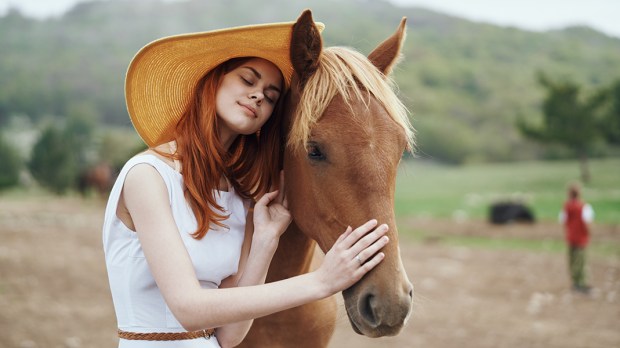Equine-assisted therapy is a growing trend for people seeking an alternative for dealing with both physical and emotional issues. Working with horses has proven to be very effective and full of benefits that go beyond the obvious, even touching the souls of patients.

Read more:
The Know-Nothing Thing About Horses
Although equine therapy wasn’t formally established until the late 1960s in the United States – with the founding of the North American Riding for the Handicapped Association – the use of horses as a path to wellbeing goes back to the ancient Greeks and the writings of Hippocrates (460 BC), who spoke of horseback riding as a method to achieve good health.
The uses of this kind of therapy are wide, from addressing emotional growth, anxiety and depression, to ADD, autism, movement disabilities, and even dementia. The activities that surround the therapies, and the bond created with the horse, allow patients to solve their psychological problems, to rehabilitate mental health issues, and to improve muscular strength.
Why are horses so good for us, anyway?
Therapies with horses are effective because their behavior is similar to that of humans, making it easier for both to relate and create a bond. They have strong personalities, they are sensible, stubborn and even rebellious, which are characteristics they share with people. However, horses also have a unique feature — they are able to mirror the rider’s emotions, they can perceive the emotional state the person is in, and somehow give feedback through their own actions. For example, they react evasively to an aggressive treatment, but they act tenderly when a person is sad. They are non-judgmental, and have no expectations the way a person (even a therapist) could, so this opens a line of communication that allows a person to open up, reflect, and solve situations that were otherwise hard to figure out.
Studies have shown that it is possible to develop a feeling of intimacy and emotional bonding through having contact with the horse, being close to it, petting it and grooming it, for example. Because of this, many studies suggest that activities involving horses, such as equine therapy, are particularly useful during adolescence, when social support, self-esteem, and social interaction are being developed.
Work from the inside
There are several types of therapies, according to the need of the patient. But at the crux of every one is the interaction between horse and human, along with an equine expert and a psychologist or doctor. Some of the interactions involve riding, but not all, since the objective is not a riding lesson per se, but an opportunity to create a bond with the animal. Having said that, it is very common to stay with both feet on the ground; feeding, grooming, leading, and even painting the horses in some cases!

Read more:
“Husband Horses” and the Feminization of the Horse Industry
Sessions are usually long, maybe 4 to 5 hours, and in some cases can last a whole day, since most are based on building trust. To do it, the equine therapist gives the patient goals to achieve, such as convincing the horse to follow him without touching it. The expert may give some clues on the way, but mostly observes the behavior of the person, and then helps out with feedback after the session.
How do you find a horse therapy program?
It’s a lot easier than you may think. More than 850 riding academies are member sof the Professional Association of Therapeutic Horsemanship International, and you can search for a location near you by going to the PATH Intl web page.
At one such site, the Heartland Equine Therapeutic Riding Academy in Omaha, Nebraska, patients have access to 20 therapy horses. The are usually older animals of various breeds, retired from different career paths (showing, racing, work horses) and they can spend two to six months re-training for the therapy program, explains Lisa Shkolnick, who has a degree in elementary school education and works on fundraising and spreading awareness of the program.
The magic of equine therapy is finding answers without talking, without hearing others’ opinions. Instead, the issues, the feelings, and the emotions are mirrored by the horses, so the person can see right through them. This allows the patient to develop those skills that were lacking, to work on communication, self-confidence and self-control.
“I was a little bit skeptical at the beginning, but as soon as you are next to the horses you feel relaxed, I don’t know why, but they give you peace,” says Gina, a woman who took equine therapy to get over a depression caused after a break up.
Her therapy consisted of convincing a couple of horses to follow her without touching them. “More than words, I had to find a way to communicate with them, not verbally. It was hard, but then I understood that if I wasn’t confident enough, firm, and persistent, without being aggressive of course, they wouldn’t do what I asked them to. They would never respect me if I didn’t inspire respect,” she mentions. After a few tries, she managed to make both horses follow her. “All of your issues and weaknesses flash before your eyes, and you learn a lot about yourself. I learned mostly about self respect, about getting over my fears and about trusting my instinct.”
Social aid
Horses have helped patients build a sense of self-worth and self-concept, improvement of communication and trust, reducing isolation and feeling of loneliness, developing emotional intelligence, and setting boundaries. Mastering skills related to handling and interaction with a large animal may give a feeling of accomplishment and competence important for self-esteem.
One of the most popular therapies of this kind consists of dealing with couples’ problems. Mario, a man who just finished a session of couples’ therapy with his fiancé, explained: “We were dealing with a lot of problems involving living together, the wedding and the previous issues we hadn’t solved, so a friend suggested this therapy. We tried it and it helped us immediately.” Their therapy consisted of a five-hour session in which, without speaking, they had to saddle the horse and get it ready. Then one of them got on the horse blindfolded and had to trust the other would lead wisely.

Read more:
Darwin’s “strangest animal ever” identified using DNA evidence
“Communicating without words happened to be easier, which made me realize we overcomplicate things when we speak, we learned to be more direct. Another very important thing was that we built a stronger bond of trust,” Mario continued. “Horses are intimidating, so closing your eyes and opening your arms makes you vulnerable. It helped me meditate about the achievements we’ve had together, the flaws in our communication, and the importance of being a team.”
Identifying and coping with feelings is one of the strongest results of this kind of therapy, since it creates a safe space, free of judgment. The horse becomes a friend, a confident, and since they can mirror feelings, they allow the person to blow off steam, while providing comfort. Horses are not easy to fool, they know when you are not being honest, so they force you to be realistic about your situation, and face it.
A medical mind
The benefits are not limited to the psychological and social fields. The medical field has found several ways that working with horses helps children with medical problems or disabilities, including spinal cord injuries and sclerosis, as well as stroke victims. One of those therapies consists of riding the horse – since the movement mimics the movement of walking – to relax the muscles, increase balance, add flexibility, and have a bigger sense of control.
It is also useful for those with decreased muscle tone because of Down syndrome, sclerosis, or brain injuries, among others. The exercise allows the weak muscles to get stronger through a gentle stimulation, plus it also improves stability. Autism has been one of the biggest areas of opportunity for this kind of therapy, since patients have shown it’s easier for them to bond and communicate with horses and then transfer this step towards people.
One of the biggest success stories out of the Heartland Equine Therapeutic Riding Academy is 4-year-old twins Alex and Jonathan, diagnosed with autism, who were mostly non-verbal. “During their initial assessment, they were in a world of their own. We did not exist to them … at least not to the extent they would interact with us or comply with any of our requests,” explains the academy’s Lisa Shkolnick. “In fact, we do not recall a single instance of eye contact from either of these two youngsters. We knew getting the boys on the horse and moving was where we needed to begin.”
After two and a half months, Jonathan reached for rings, handed them to the volunteer and placed them on the corresponding color on the ring tree. Alex, the less verbal of the twins, began to use more expressions, such as telling his horse to “walk on.” The twins also engaged in more eye contact, and interacted with their environment.
There are many things that can be learned by working with these noble animals, from compassion to strength. And observing what can be accomplished allows us to strengthen our hope and our faith.

